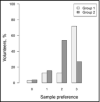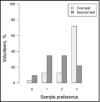Salt preferences of normotensive and hypertensive older individuals
- PMID: 25039751
- PMCID: PMC8032177
- DOI: 10.1111/jch.12365
Salt preferences of normotensive and hypertensive older individuals
Abstract
The aim of this study was to evaluate the preference for salt in hypertensive and normotensive older individuals. Hypertensive (group 1: n=32, aged 73.7±6.3 years) or normotensive patients (group 2: n=26, aged 71.5±8.0 years) were submitted to a test to determine their preference for bread samples with different salt concentrations: 1.5%, 2.0% (usual concentration), and 2.7%, and were reevaluated 2 weeks later using the same salt concentrations, but with the addition of oregano. Twenty-four-hour urinary sodium excretion (UNaV), blood pressure (BP), and body mass index (BMI) were obtained. Systolic BP, BMI, and UNaV were higher in group 1. In the first analysis, group 1 showed greater preference for the saltiest sample (P=.001). Comparing the first evaluation and the second, a greater preference for less salty samples was observed in both groups (P<.01). Hypertensive older patients consumed more salt and showed a greater salt preference than the normotensive patients. The use of the spice reduced the preference for salt in both groups.
©2014 Wiley Periodicals, Inc.
Figures



References
-
- Fallis N, Lasagna L, Tetreault L. Gustatory thresholds in patients with hypertension. Nature. 1962;196:74–75.
-
- Bisht DB, Krishamurthy M, Rangaswamy R. Studies on threshold of taste for salt with special reference to hypertension. Indian Heart J. 1971;23:137–140. - PubMed
-
- Jan RA, Shah S, Saleem SM, et al. Sodium and potassium excretion in normotensive and hypertensive population in Kashmir. J Assoc Physicians India. 2006;54:22–26. - PubMed
-
- Murphy C, Whithee J. Age‐related diferences in the pleasantness of chemosensory stimuli. Pshycol Aging. 1986;1:312–318. - PubMed
Publication types
MeSH terms
Substances
LinkOut - more resources
Full Text Sources
Other Literature Sources
Medical

